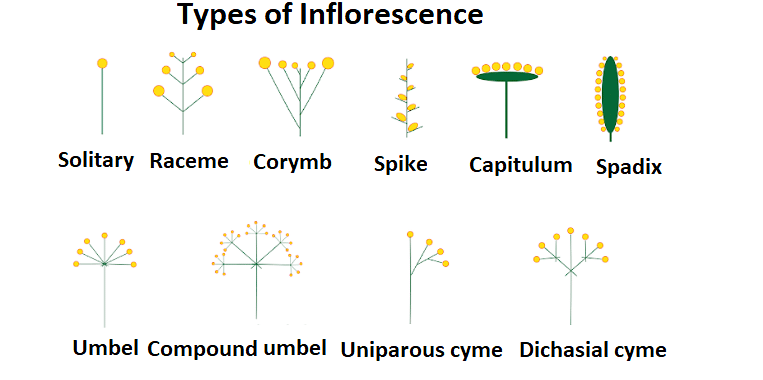The inflorescence in Ocimum is
- cyathium
- verticillaster
- hypanthodium
- raceme
The Correct Option is B
Approach Solution - 1
Approach Solution -2
The Correct Option is (B): verticillaster
Verticillaster inflorescence:
- Inflorescence is described as the arrangement of flowers on the floral axis.
- A type of inflorescence in which the flowers are aligned in a seeming whorl, generally sessile cymes, comprising a pair of opposite axillary is verticillaster inflorescence.
- A verticillaster refers to a fascicle with the composition of a dichasium and is a common feature among the members of the family of 'Lamiaceae'.
- 'Lamiaceae' - a family of flowering plants commonly known as the mint or sage family.
- Some examples are rosemary, basil, lavender, mint, etc.
- Ocimum is a genus of aromatic perennial and annual herbs and shrubs in the Lamiaceae family.
- It is further called tulsi or holy basil.
- Thus, the inflorescence commonly found in Ocimum or Basil is verticillaster inflorescence.

Approach Solution -3
The Correct Option is (B): verticillaster
Verticillaster - a special type of inflorescence that is similar to condensed dichasial cyme inflorescence. Each dichasial cyme changes to a monochasial cyme of scorpioid type.

It is a raceme of verticals (whorls of flowers) borne on a rectangular axis in the axils of opposite leaves. There are two verticals at each node where each whorl consists of two clusters of 3-9 flowers, e.g., Ocimum (Tulsi), Saluia, and Leucas.
The correct option is (B).
Approach Solution -4
The arrangement of flowers and distribution over a plant is known as inflorescence. The manner of arrangement occurs on a peduncle which is the axis of inflorescence.
Complete answer:
The inflorescence is divided into four main types-
- Racemose inflorescence grows continuously as the main axis does not end in a single flower.
- In cymose inflorescence, only a definite or determinate number of flowers are formed. because the peduncle or the main axis ends in a single flower.
- Mixed inflorescence, is where two or more types of inflorescence get mixed up and form some special types of inflorescence.
- A special type of inflorescence, Tulsi(Ocimum) of Labiate exhibits Verticillaster inflorescence.

Therefore, the correct answer is ‘Verticillaster'.
Note: Tulsi, mints, and spearmint are members of an important medicinal plant family ‘Labiate’ or ‘Lamiaceae’ which exhibits verticillaster inflorescence. They are usually small herbs or shrubs with aromatic smells and cultivated for various purposes- medicinal, ornamental, culinary, and perfumery being some of them. A sacred plant grown in the Indian household for centuries is Tulsi which is described as a healing herb in Hindu traditions. It plays an important role in Ayurvedic medicines. Its medicinal properties include anti-microbial, anti-allergic, and anti-diabetic.
Top Questions on The Inflorescence
- In a cymose type of inflorescence, the growth of the main axis terminates in a:
- UPSEE - 2016
- Biology
- The Inflorescence
- The inflorescence found in banana is
- UP CPMT - 2015
- Biology
- The Inflorescence
- The partial floral formula of a flower is $K_{\left(5\right)} C_{5}A_{\left(\infty\right)} \frac{G_{5}}{ }$ Which f the following set of information is conveyed here?
- WBJEE - 2014
- Biology
- The Inflorescence
- The inflorescence in which sessile flowers are borne acropetally on an elongated rachis, it is called
- AMUEEE - 2014
- Biology
- The Inflorescence
- Which one of the following is correct explanation for the floral formula $\quad\quad\% \Theta K_{\left(5\right)} C_{1+2+\left(2\right)}A_{\left(9\right)+1 }G_{1}$
- KEAM - 2013
- Biology
- The Inflorescence
Questions Asked in JIPMER exam
- Binomial nomenclature was first introduced by
- JIPMER - 2015
- KCET - 2022
- Diversity In The Living World
- $2,4-DNP $ test can be used to identify :
- JIPMER - 2021
- Chemical Reactions
- A convex lens $'A'$ of focal length $20\, cm$ and a concave lens $'B'$ of focal length $5\, cm$ are kept along the same axis with a distance $'d'$ between them. If a parallel beam of light falling on $'A'$ leaves $'B'$ as a parallel beam, then the distance $'d'$ in cm will be :
- JIPMER - 2021
- Spherical Mirrors
- A bacterial flagellum is composed of
- JIPMER - 2021
- Prokaryotic Cells
- How many moles of acidified $K_2Cr_2O_7$ is required to liberate $6$ moles of $I_2$ from an aqueous solution of $I^-$ ?
- JIPMER - 2020
- Mole concept and Molar Masses
Concepts Used:
Inflorescence
The term inflorescence comes under the method morphology of flowering plants. The Morphology of flowering plants is the study of different parts of the plants, which includes the leaves, flowers, fruits, and stems. In a plant, the flowers either grow individually or in a set of groups, and the groups of flowers are referred to as inflorescence.

Inflorescence can also be referred to as the reproductive part of a plant that contains a group of flowers. It is responsible for the positioning of flowers on the floral axis and it is divided into two categories: racemose inflorescence and cymose inflorescence. In the racemose inflorescence, the main axis keeps on growing and the flower develops itself in an acropetal pattern while in the cymose inflorescence the termination of the main axis takes place and the flower grows in a basipetal pattern.